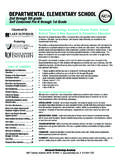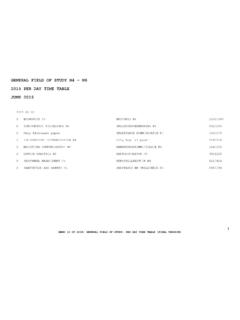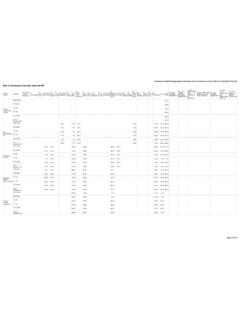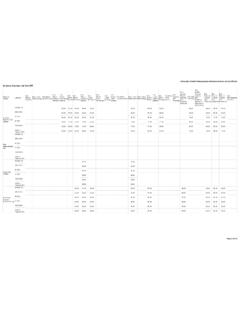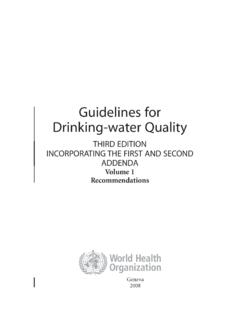Transcription of Process Capability Studies - Weibull
1 Process Capability Studies Definition The quality of a production Process is subject to certain fluctuations. What are known as Capability indexes are calculated so that these processes can be assessed, with a broad distinction being made between machine Capability Studies on the one hand and Process Capability Studies on the other. Both are designed to identify and evaluate random and also systematic influences. Procedure The specialist department shall stipulate the properties definitive for the Capability indexes. It is impractical to apply Process Capability to each individual part. Instead function-critical or quality-critical properties of the assembly should be considered. Single parts that are not capable by themselves, can be classed and paired so as to achieve a capable functional dimension in the assembly, for example the bearing shell and crank pin. If re-adjustment takes place in final assembly, the Process property of the finished product shall be assessed, body parts and their gap dimensions.
2 Fundamentals The distributions to be used are: Normal distribution Folded normal distr. B1 Folded normal distr. B2 Log-normal distribution Weibull distribution Mixed distribution Form Exampl. Geometric dimensions diameter, length, etc. Properties limited on one side, roundness, parallelism Properties limited on one side, imbalance, co-axiality Properties limited on one side, true-running Properties limited on one side, with time reference Con-mingling of Process fluctuations, machines, batches, etc. Param. 2-parameter (Gaussian standard) Negative proportions are mirrored at x=0 Corresponds to Weibull distribution with b=2 2-parameter 2- or 3-parameter Only triple mixed distribution on basis of proportional normal distribution allowed Calculation Calculation analytic by + Calculation analytic with folding <> 0 Calculation by least-square y Calculation analytic by median & scatter factor Calculation by least-square y Calculation analytic, percentile method Formula sLSLUSLCp6 %50%865,99%50%135,0%50%50;XXXUSLXXLSLXMi nCpk Process Capability Studies Important notes: 1.
3 Invariably, distributions are assigned with the technical context taken duly into account. In the case of the roundness property, for example, the distribution to be used is the folded normal B1, even if the statistical test would accept a normal distribution. 2.) In a folded normal distribution, the mean value is determined from the data and not set to 0 (folding <> 0). 3.) A mixed distribution shall be used only if the normal distribution is rejected by the statistical test! The folded normal distributions for standard properties are given as follows: In addition to the normal distribution, for a unit of length, additional distribution types exist for the subsequent characteristics: Machine Capability study A machine Capability study reveals the short-term scatter and the production and repeat precision of the machine when, under near-series conditions, only machine-related influences apply. This is sometimes also referred to as a short-term Capability study.
4 The purpose of the study is to ascertain a machine's Capability with regard to the production Process . In principle, a machine Capability study has to be conducted for each new machine in the framework of acceptance testing. Reasons for deviations from this standard practice shall be given and the deviations documented. LN* Log-normal distribution B1 Folded normal 1st type B2 Folded normal 2nd type * If LN is not offered in the evaluation strategy it can be mapped by using the 3-parameter Weibull distribution. Process Capability Studies Calculation of the indexes for Process Capability Evaluation is carried out entirely in accordance with the evaluation strategy described in the Appendix. The relationships as stated below shall apply for properties with normal distribution (standard deviation ascertained by single-sample strategy, verification of normal distribution by the Anderson-Darling test.)
5 SLSLUSLCm6 sLSLxsxUSLMinCmk3,3 where x and s are calculated from the specified sample. For all other properties with non-normal distribution, such as folded normal distribution, for example, calculation shall be by analogy with the descriptions for Process Capability . Requirement for machine Capability The requirement is satisfied if: mC > ; mkC > Sample size Sample size shall be 50. Parts manufactured in direct sequence shall be removed from the machine. The prerequisite is that production of these parts must be under series conditions. In justified exceptions, for example short-run production, a smaller sample size is possible but shall be documented (evaluation is impractical with fewer than 20 parts). If the sample size is less than 50, the requirement applies with reference to the lower confidence limit (confidence interval 95%, table by analogy with VDI/VDE 2645): n Cmk 20 25 30 35 40 45 50 with nspec = 50 Cmk1,675020capable nconfidence-limitnodeclarationnot capable notcapable* Process Capability Studies * Cmk for existing plant, on repeat acceptance testing after repair or other modifications, also permissible for sample sizes n<50 (no provision for confidence interval made) Boundary conditions The Capability study shall also be conducted after repairs, on a change of production, after modification to the machine and/or relevant part properties and on production of new parts.
6 Necessary interventions shall be documented (planned interventions can be routine adjustments to the Process necessitated by a trend). If an unplanned intervention is necessary the study shall be restarted from the beginning. Data shall not be sorted out (see example in the Appendix, isolated outliers are the exception, proved by a statistical outlier test and with technical reason). A machine Capability study shall be conducted regularly for threaded fastener technology, with the concurrence of the specialist department. Other, agreed regulations shall be applied. Process Capability Studies Process Capability Studies , also known as long-term Capability Studies , establish the long-term quality Capability of the entire Process . A study of this nature aims at taking all the influencing variables listed below duly into account. A Process Capability study is the prerequisite for Process monitoring/steering, particularly with control charts or statistical Process control (SPC).
7 A Process Capability study is conducted for the first time when a new Process is introduced. The Process Capability study has to be repeated at least when, for example, a relocation or a serious change in the production Process has taken place. Information indicating which changes necessitate this is set out in the production- Process and product-release Process (see VDA Volume 2). Calculation of the indexes for Process Capability Evaluation is carried out entirely in accordance with the evaluation strategy described in the Appendix. Properties with normal distribution The relationships as stated below shall apply for properties with normal distribution (standard deviation ascertained by single-sample strategy, verification of normal distribution by the Epps-Pulley test (n>1000 test). Alternatively, the Anderson-Darling test can also be used. sLSLUSLCp6 sLSLxsxUSLMinCpk3,3 Note: The sample sizes were grouped for calculation of s in the formula above.)
8 Process Capability Studies niixxns1211 Properties with non-normal distribution For all other properties with non-normal distribution and upper specification limit only (natural lower limit at 0): %50%865,99%50 XXXUSLCCpkUpk X50% = median If there is a lower specification limit as well, for example for minimum surface roughness, Cpu has to be calculated as well: %135,0%50%50 XXLSLXCpkL Process Capability is then expressed as: %50%865,99%50%135,0%50%50;XXXUSLXXLSLXMi nCpk Requirement for Process Capability The requirement is satisfied if: pC > ; pkC > Process Capability shall be verified no later than three months after the start of standard production. The measured data of the machine Capability study cannot also be incorporated into the Process Capability study, because long-term influences are not taken into account in the machine Capability study. Sample size In this instance 'sample size' means the total number of measurements taken to calculate the Cp and Cpk indexes.
9 Split, usually cyclic single samples ni are needed for the purpose of ascertaining whether a Process is stable. n : scope of complete data USL - X50% USL X50% - X50% X50% - LSL X50% X50% - LSL Process Capability Studies The total size of the sample is defined as 125, individual samples to be taken uniformly from production over a period of 10 to 20 weeks, or over 4 weeks at least. Ensure that the Process proceeds under series conditions when sampling is in progress and is not disrupted or changed. An intervention is permissible only between samples and shall be documented. If parts are removed only in samples, the possibilities include the following: Ensure that Process -changing influences are taken into account, for example tooling and set-up processes, shift changes, batch changes (raw material), etc. The single samples ni mentioned above shall be defined accordingly and should be at least 5 in number.
10 In justified exceptions, for example short-run production, a smaller sample size is possible but shall be documented (min n 20). Data shall not be sorted out (see example in the Appendix, isolated outliers are the exception, given technical reason, or proved by a statistical outlier test). If the sample size is n < 125, the requirement applies with reference to the lower confidence limit (confidence interval 95%, table by analogy with VDI/VDE 2645). n Cpk 20 25 30 40 50 60 70 80 100 125 with ntotal = 125 Random samples Random samples from subgroups Cyclic removal from Process in progress Process Capability Studies Boundary conditions In order for the indexes to the calculated the Process data must correspond to the statistical basics such as stability and controllability. Capability and stability are prerequisites for a forecast of the Process .





